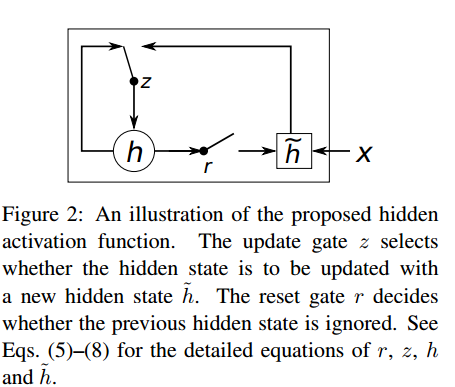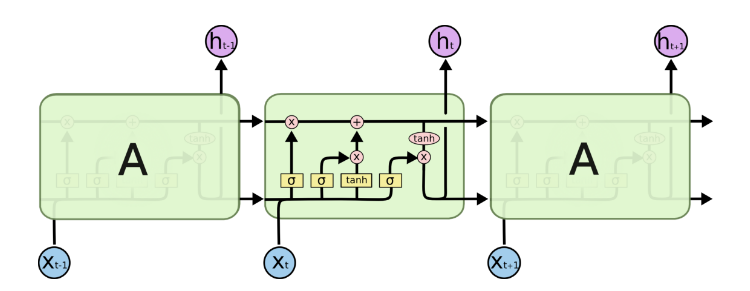TF_RNNCell
参考:链接。
RNNCell
- BasicRNNCell
- GRUCell
- BasicLSTMCell
- LSTMCell
- MultiRNNCell
抽象类RNNCell
所有的rnncell均继承于RNNCell, RNNCell主要定义了几个抽象方法:
def __call__(self, inputs, state, scope=None):
raise NotImplementedError("Abstract method") @property
def state_size(self):
raise NotImplementedError("Abstract method") @property
def output_size(self):
raise NotImplementedError("Abstract method")
上述方法,__call__在对象被使用时调用,其他可以看做属性方法,主要用作获取状态state的大小,cell的输出大小。既然对象使用时会调用__call__,那么各类RNN的操作都定义在这个方法中。接下来,我们就针对各个不同的cell来详细介绍各类RNN。
BasicRNNCell
这个cell是最基础的一个RNNCell,可以看做是对一般全连接层的拓展,除了在水平方向加入时序关系,可以用下图表示:

而BasicRNNCell的初始化方法可如代码所示:
def __init__(self, num_units, input_size=None, activation=tanh):
if input_size is not None:
logging.warn("%s: The input_size parameter is deprecated.", self)
self._num_units = num_units
self._activation = activation
初始化只需要给出num_units,用来指有多少个隐藏层单元;而activation指使用哪种激活函数用作激活输出。而对应的RNN操作定义在__call__方法中:
def __call__(self, inputs, state, scope=None):
"""Most basic RNN: output = new_state = activation(W * input + U * state + B)."""
with vs.variable_scope(scope or type(self).__name__): # "BasicRNNCell"
output = self._activation(_linear([inputs, state], self._num_units, True))
return output, output
很清晰,inputs表示隐藏层的输入,state表示上个时间的隐藏层状态,也可以说是上一次隐藏层向自身的输出,对于第一次输入,则需要初始化state,对应初始化方法有很多种,可以使用tensorflow提供的各种初始化函数。在__call__中,对输入inputs和state进行activation(wx+b),用作下次的输入。
GRUCell
GRU是对RNN的一种改进,相比LSTM来说,也可以看做是对LSTM的一种简化,是Bengio在14年提出来的,用作机器翻译。先看一下GRU的基本结构:

这里我们结合代码来看原理:
def __call__(self, inputs, state, scope=None):
"""Gated recurrent unit (GRU) with nunits cells."""
with vs.variable_scope(scope or type(self).__name__): # "GRUCell"
with vs.variable_scope("Gates"): # Reset gate and update gate.
# We start with bias of 1.0 to not reset and not update.
r, u = array_ops.split(1, 2, _linear([inputs, state],
2 * self._num_units, True, 1.0))
r, u = sigmoid(r), sigmoid(u)
with vs.variable_scope("Candidate"):
c = self._activation(_linear([inputs, r * state],
self._num_units, True))
new_h = u * state + (1 - u) * c
return new_h, new_h
GRUCell的初始化与RNN一样,给出输入和初始化的state,在使用对象时,利用输入和前一个时间的隐藏层状态,得到对应的Gates: r, u, 然后利用r更新cell状态,最后利用u得到新的隐藏层状态。对于RNN的改进,最厉害的莫过于下面的,而且有很多变种,这里tensorflow中只有几个简单常见的cell。接下来,我们开始看看LSTM。
BasicLSTMCell
这个cell可以看做是最简单的LSTM,在每个连接中没有额外的连接,即其他变种在连接中加入各种改进。对于BasicLSTMCell,可以如下图所示:

同样的,我们结合代码来看它的原理:
def __call__(self, inputs, state, scope=None):
"""Long short-term memory cell (LSTM)."""
with vs.variable_scope(scope or type(self).__name__): # "BasicLSTMCell"
# Parameters of gates are concatenated into one multiply for efficiency.
if self._state_is_tuple:
c, h = state
else:
c, h = array_ops.split(1, 2, state)
concat = _linear([inputs, h], 4 * self._num_units, True) # i = input_gate, j = new_input, f = forget_gate, o = output_gate
i, j, f, o = array_ops.split(1, 4, concat) new_c = (c * sigmoid(f + self._forget_bias) + sigmoid(i) *
self._activation(j))
new_h = self._activation(new_c) * sigmoid(o) if self._state_is_tuple:
new_state = LSTMStateTuple(new_c, new_h)
else:
new_state = array_ops.concat(1, [new_c, new_h])
return new_h, new_state
lstm有三个门,inputs, forget, output, 而中间cell用来管理结合他们生产需要的输出。在初始化结束之后,利用输入分别得到对应的门的输出,然后利用这三个门的信息分别更新cell和当前隐藏层状态。f 用来控制遗忘之前的信息和记忆当前信息的比例,进而更新cell,lstm可以看做是一种复杂的激活函数,它的存在依赖RNN的递归性。BasicLSTMCell只是个最基本的LSTM,而完整的LSTM可能比这个复杂,可以参看blog。
MultiRNNCell
对于MultiRNNCell,只能贴出完整代码来分析了:
class MultiRNNCell(RNNCell):
"""RNN cell composed sequentially of multiple simple cells.""" def __init__(self, cells, state_is_tuple=False):
"""Create a RNN cell composed sequentially of a number of RNNCells. Args:
cells: list of RNNCells that will be composed in this order.
state_is_tuple: If True, accepted and returned states are n-tuples, where
`n = len(cells)`. By default (False), the states are all
concatenated along the column axis. Raises:
ValueError: if cells is empty (not allowed), or at least one of the cells
returns a state tuple but the flag `state_is_tuple` is `False`.
"""
if not cells:
raise ValueError("Must specify at least one cell for MultiRNNCell.")
self._cells = cells
self._state_is_tuple = state_is_tuple
if not state_is_tuple:
if any(nest.is_sequence(c.state_size) for c in self._cells):
raise ValueError("Some cells return tuples of states, but the flag "
"state_is_tuple is not set. State sizes are: %s"
% str([c.state_size for c in self._cells])) @property
def state_size(self):
if self._state_is_tuple:
return tuple(cell.state_size for cell in self._cells)
else:
return sum([cell.state_size for cell in self._cells]) @property
def output_size(self):
return self._cells[-1].output_size def __call__(self, inputs, state, scope=None):
"""Run this multi-layer cell on inputs, starting from state."""
with vs.variable_scope(scope or type(self).__name__): # "MultiRNNCell"
cur_state_pos = 0
cur_inp = inputs
new_states = []
for i, cell in enumerate(self._cells):
with vs.variable_scope("Cell%d" % i):
if self._state_is_tuple:
if not nest.is_sequence(state):
raise ValueError(
"Expected state to be a tuple of length %d, but received: %s"
% (len(self.state_size), state))
cur_state = state[i]
else:
cur_state = array_ops.slice(
state, [0, cur_state_pos], [-1, cell.state_size])
cur_state_pos += cell.state_size
cur_inp, new_state = cell(cur_inp, cur_state)
new_states.append(new_state)
new_states = (tuple(new_states) if self._state_is_tuple
else array_ops.concat(1, new_states))
return cur_inp, new_states
创建对象时,可以看到初始化函数中不再是输入,而是变成了cells,,即一个cell是一层,多个cell便有多层RNNcell。而在使用对象时,单层可以看做多层的特例,对于输入inputs和state,同时得到多个cell的当前隐藏层状态,用作下个时间步。看似麻烦,其实很简洁,就是加入了对多个cell的计算,最后得到的新的隐藏层状态即每个cell的上个时间步的输出。
TF_RNNCell的更多相关文章
随机推荐
- DRF视图-5个扩展类以及GenericAPIView基类
视图 5个视图扩展类 视图拓展类的作用: 提供了几种后端视图(对数据资源进行曾删改查)处理流程的实现,如果需要编写的视图属于这五种,则视图可以通过继承相应的扩展类来复用代码,减少自己编写的代码量. 这 ...
- k8s 工具集
Volcano 资源调度器 apollo 配置中心 spinnaker 持续部署系统 jaeger 分布式跟踪系统.它用于监视和诊断基于微服务的分布式系统,包括: 分布式上下文传播 分布式交易监控 根 ...
- 【转帖】知乎管理华为鸿蒙OS的介绍2
作者:虎游链接:https://www.zhihu.com/question/328382980/answer/784629132来源:知乎著作权归作者所有.商业转载请联系作者获得授权,非商业转载请注 ...
- 【Python】【demo实验15】【练习实例】【两个数范围内素数的统计】
原题: 判断101-200之间有多少个素数,并输出所有素数. 关于素数的统计,之前已经做过相应的实验了,参考:[显示素数,显示两个数范围内的所有素数] 原题给出的解法,使用math的sqrt函数,这个 ...
- JZOJ.1002【USACO题库】1.1.3 Friday the Thirteenth黑色星期五
每日一博第一天! 保持你的决心 题目描述 13号又是星期五是一个不寻常的日子吗? 13号在星期五比在其他日少吗?为了回答这个问题,写一个程序来计算在n年里13 日落在星期一,星期二......星期日的 ...
- Luogu P4426 [HNOI/AHOI2018]毒瘤
题目 神仙题. 首先我们可以把题意转化为图的独立集计数.显然这个东西是个NP-Hard的. 然后我们可以注意到\(m\le n+10\),也就是说最多有\(11\)条非树边. 我们现在先考虑一下,树上 ...
- sqlalchemy定义mysql时间戳字段
update_time = Column(TIMESTAMP, nullable=False, comment='更新时间戳', server_default=text('CURRENT_TIMEST ...
- 基于从库+binlog方式恢复数据
基于从库+binlog方式恢复数据 将bkxt从库的全备份在rescs5上恢复一份,恢复到6306端口,用cmdb操作 恢复全备后执行如下操作 set global read_only=OFF; st ...
- redis 学习(20)-- 常见的持久化开发与运维问题
常见的持久化开发与运维问题 fork 操作 fork 操作是一个同步操作,若执行较慢会阻塞 redis 主线程 执行时间与内存量相关:内存越大,耗时越长:虚拟机较慢,真机较快 查看 fork 执行时间 ...
- 用winform实现一个B/S代码更新打包工具
一个.net程序员必须拥有的能力就是可以随时随地写出一个自己需要的小工具,于是记录一下我的个人工具吧. 新建一个窗体应用项目,代码如下: namespace 打包工具 { partial class ...
